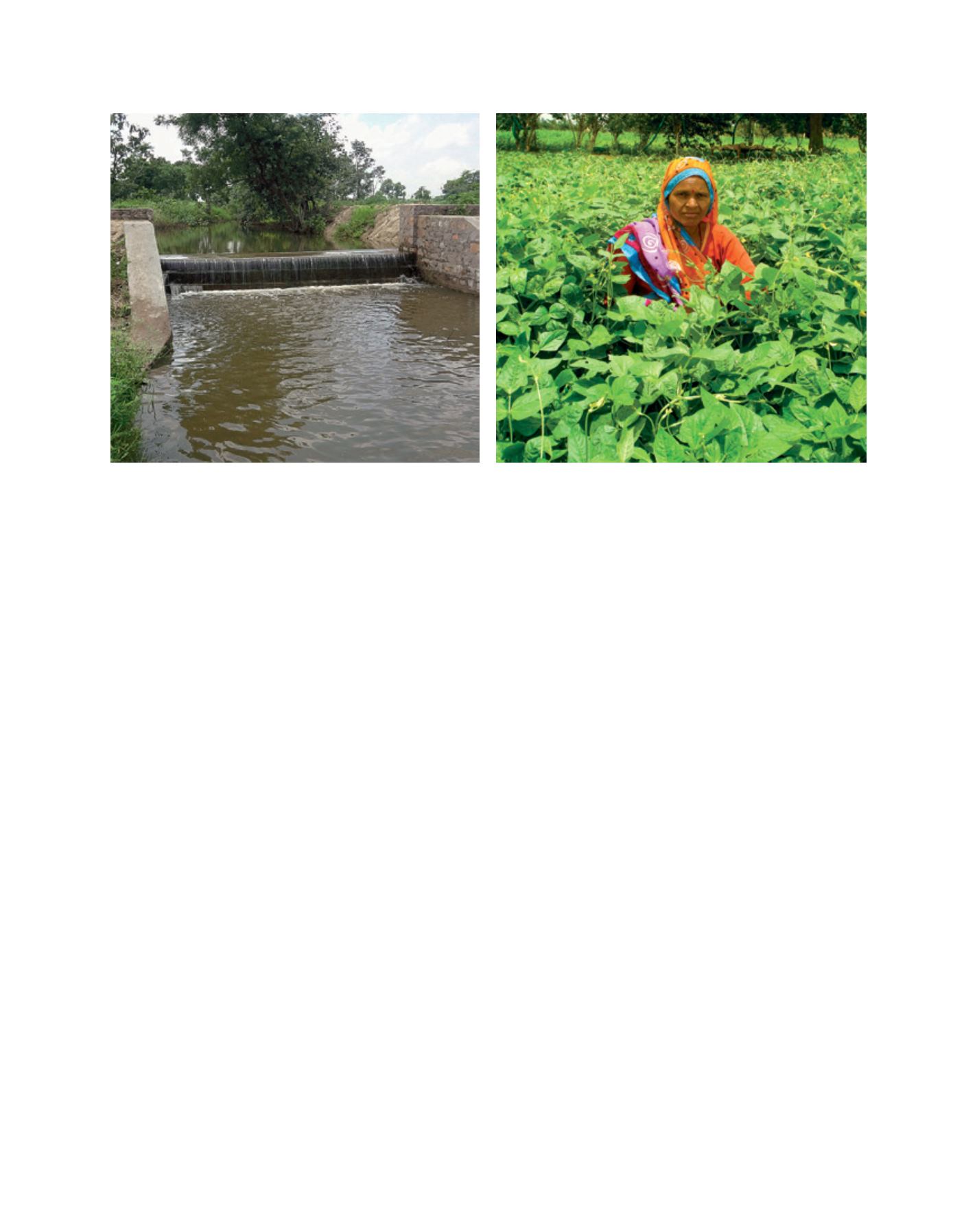

[
] 99
by 50 per cent especially during post-monsoon season (
rabi
season). Productivity of post-monsoon crop especially wheat
has doubled after the watershed interventions. Wheat yield
before the watershed interventions ranged from 1,500 to 1,800
Kg ha
-1
. Despite the good establishment of crop, there was high
chance of crop failure due to depleted water resources between
January and February and supplemental irrigation was not
possible due to drying wells. After implementing the watershed
programme, farmers began harvesting wheat yield ranging from
3,000 to 4,000 kg ha
-1
resulting in significant improvement in
their income and livelihood. Farmers have shifted cropping
pattern from low-income crops (chickpea and mustard) to
high-income crops (vegetables and wheat) and fodder availabil-
ity has increased significantly. Agro-forestry has strengthened
by promoting tree plantation on farm bunds and wasteland
with community participation. Improved varieties of chickpea
and wheat were introduced and crop yields increased from
by 30 to 50 per cent. In addition, various income-generating
activities such as vermicomposting, nursery raising and other
micro-enterprises helped farmers to earn additional income.
Watershed interventions enhanced average annual family
income from 50,000 INR (US$830) to 125,000 INR (US$2,080)
in a period of three to four years clearly indicating the potential
of science-led interventions to address the food security and
rural livelihood issues in drylands.
Lucheba, China
Lucheba village in Pingba County, Guizhou province in southern
China comprises a cluster of six villages with 340 households
and 1,373 people. It was selected in 2003 for integrated water-
shed interventions by ICRISAT and its partners. Before this, the
cropping systemwas largely maize, rice, soybean, sunflower and
rapeseed. There was high pressure on women as they had to
travel long distances to fetch drinking water due to water scar-
city even for domestic use. Migration levels were high as people
sought other livelihood options and men were largely engaged
for labour work in the construction sector. In 2003, based on
discussions with the village communities, two drinking water
schemes were undertaken as an entry point activity with project
funds and partial contributions from villagers. Spring water from
the hilltop was tapped and brought down to the village through a
pipeline system. Further watershed interventions such as soil and
water management, improved cropping systems, crop diversifica-
tion, integrated nutrient and pest management practices, along
with other income-generating activities such as poultry and pig
rearing, were introduced. Altogether 151 rainwater harvesting/
irrigation water storage tanks of 5 m
3
capacity were constructed;
nearly 133,000 trees were planted on 100 ha of wasteland, and a
4.8 km village approach road was built from the main road. Later
a 6 km-long field road was also constructed with government
support. Crop diversification was undertaken with high-value
vegetable crops. More than 260 biogas plants were set up in
village households to reduce pressure on fuelwood and protect
the forests. Micro-enterprises for women were promoted along
with forage production on bunds.
Watershed interventions completely transformed the liveli-
hood of the people. Average annual income from agriculture
has increased threefolds (from US$500 to US$1,650). The
benchmark crops (rice, corn, rape, soybean, sunflower and
kidney bean) were replaced with high-value crops like water-
melon and vegetables like tomato, pumpkin, cabbage, chilli
and eggplant using hybrid seeds and improved agronomical
practices. Lucheba now boasts two animal health centres, an
Internet-enabled farmers’ training centre and one Vegetable
Growers’ Association. The whole village currently has biogas-
powered street lighting. The migration level has been drastically
reduced and those who had migrated to cities have returned to
villages as the quality of life is better than the city with more
opportunity to work in the village itself. The village’s average
per capita income is twice that of the province.
Parasai-Sindh watershed, Bundelkhand region, central India: (left) over and base flow from a check-dam indicates increased groundwater and surface water
availability; (right) farmer cultivating vegetable as cash crop
Images: ICRISAT
L
iving
L
and
















